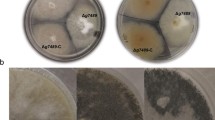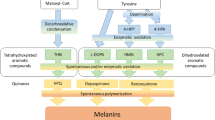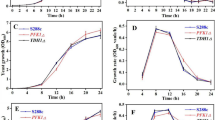Summary
Sugar consumption as measured by fructose disappearance from culture filtrates is much quicker in ammonium, mycelial (M) than in nitrate, conidial (C) cultures of Neurospora crassa. This disappearance rate is slowed down to that of C filtrates in ammonium cultures enriched with glycine acting as conidiating agent. Similarly, ammonium cultures in which d-xylose is substituted to sucrose as carbone source are fully conidiated and the pentose is removed in 5 days from the filtrates. Various antiglycolytic agents such as iodoacetate and phtiocol are highly conidiogenous in the M medium. In filtrates of all C-induced cultures, ethanol is found in traces only comparatively to M filtrates.
High ethanol as well as relatively elevated concentrations of acetaldehyde are measured in filtrates of wild type cultures on M medium only while ethanol and acetaldehyde are high in filtrates of both M and C cultures of the macroconidialess “fluffy” strain. A high glycolytic activity is also detected in cultures of “amyc” and a few other morpho-biochemical mutants.
Zn deficiency in the M medium also leads to less alcohol production, lower CO2/O2 respiratory quotient and fair conidiation while reverse effects can be obtained with excess of Zn ions in the C medium.
In M cultures, ammonium disappearance is practically achieved in 5 days like nitrate from C medium. M extracts contain two to three times more free α-alanine than those of C. Carotenoids synthesis is slow and remains relatively low in the vegetative mycelia; it is higher in the microconidia and especially the macroconidia.
M→C “conversion” effects through iodoacetate addition is restricted to the first 36 hours after inoculation of the M medium. Conidial induction can be prevented with 5-fluorouracil. Inverse effects C→M are obtained with bisulfite trapping acetaldehyde or with addition of NH4Cl (first 8 hours only).
Electron microscopy of microconidiating apparatus in the “fluffy” strain has revealed lamellated structure of collerette terminating the phialide-like mother cell; scarcity of poorly organized mitochondria contrasting with their development in control, macroconidial cultures, density of the cytoplasm surrounded by a membranous and dark external wall (chitinous and melanic) are striking features of microconidia. Cytoplasmic ultrastructure is similar in the mutant “amyc” (apophragmous and especially aschizogenous) except for the additional feature of an endoplasmic reticulum narrowly lining up exceptionally thick walls which maintain successive, incomplete conidia united in a pseudomycelial structure.
Résumé
La consommation du sucre, mesurée par la disparition du fructose des filtrats, est beaucoup plus rapide dans les cultures de Neurospora crassa sur milieu ammoniacal (mycéliennes, M) que sur nitrate (conidiennes, C). Cette disparition est ralentie au rythme de celle des filtrats C dans les cultures ammoniacales enrichies de glycine exerçant un effet conidiogène. De même, les cultures ammoniacales dans lesquelles de d-xylose est substitué au saccharose en tant que source de carbone sont couvertes de conidies et le pentose disparaît en 5 jours des filtrats. Divers agents antiglycolytiques tels que l'iodoacétate et le phthiocol sont fortement conidiogènes dans le milieu M. Dans les filtrats de toutes les cultures induites en C, l'éthanol n'a été trouvé qu'en traces en comparaison des filtrats M.
Une haute teneur en éthanol ainsi que des concentrations relativement élevées d'acétaldéhyde ont été mesurées dans les filtrats de cultures du type sauvage sur milieu M seul alors que les taux d'éthanol et d'acétaldéhyde sont élevés tant dans les filtrats de cultures M que de C avec la souche «fluffy», incapable de former des macroconidies. Une haute activité glycolytique a aussi été détectée dans les cultures de la souche «amyc» et de quelques autres mutants morpho-biochimiques.
Une déficience en Zn dans le milieu M réduit aussi la production alcoolique, abaisse le quotient respiratoire CO2/O2, tout en favorisant une conidiation modérée; des effets inverses sont obtenus en présence d'un excès d'ions Zn dans le milieu C. Dans les cultures M, l'ammoniaque disparaît en 5 jours des filtrats, comme d'ailleurs le nitrate du milieu C.
Les extraits de mycélias M contiennent de deux à trois fois plus d'α-alanine libre que ceux de mycélias conidiogènes C. La synthèse des caroténoïdes est lente et reste relativement faible dans les mycélias végétatifs mais est importante dans les microconidies et surtout dans les macroconidies.
Les effets de «conversion» M→C par addition d'iodoacétate sont limités aux premières 36 heures après l'inoculation du milieu M. L'induction conidienne peut être empêchée par le 5-fluorouracil. Des effets inverses C→M sont produits par complexion de l'acétaldéhyde par le bisulfite ou par addition de NH4Cl (premières 8 heures).
L'étude au microscope électronique de l'appareil microconidien de la souche «fluffy» a révélé la structure lamellée de la collerette placée au sommet de la cellulemère phialiforme; parmi les caractéristiques des microconidies, relevons les mitochondries peu abondantes et peu organisées par comparaison avec celles des macroconidies, la densité du cytoplasme entouré d'une paroi externe membraneuse et foncée (chitineuse et mélanique). L'ultrastructure cytoplasmique est similaire chez le mutant «amyc» (apophragmique et surtout aschizogène), à l'exception du réticulum endoplasmique appliqué le long de parois particulièrement épaisses contribuant au maintien des unités conidiales incomplètes en une structure pseudomycélienne.
Similar content being viewed by others
Bibliographie
Axelrod, B.: Other pathways of carbohydrate metabolism, p. 205. In: D. M. Greenberg: Metabolic Pathways. Vol. I. London and New York: Academic Press Inc. 1960.
Backus, M. P.: The mechanics of conidial fertilization in Neurospora sitophila. Bull. Torrey bot. Club. 66, 63 (1939).
Barratt, R. W., and L. Garnjobst: Genetics of a colonial microconidiating mutant strain of Neurospora crassa. Genetics 34, 351 (1949).
Beadle, G. W., and E. L. Tatum: Neurospora II. Methods of producing and detecting mutation concerned with mutational requirements. Amer. J. Bot. 32, 678 (1945).
Bianchi, D. E., and G. Turian: Nuclear division in Neurospora crassa during conidiation and germination. Experientia (Basel) 23, 192 (1967).
Braune, W.: Chinone als Fungizide. Die Geschichte ihrer Erforschung und die Ansichten über ihre Wirkungsweise. Zbl. Bakt., II Abt. 117, 412 (1964).
Cantino, E. C.: The relationship between biochemical and morphological differentiation in non-filamentous aquatic fungi. Symp. Soc. gen. Microbiol. 11, 243 (1961).
De Terra, N., and E. L. Tatum: A relationship between cell wall structure and colonial growth in Neurospora crassa. Amer. J. Bot. 50, 669 (1963).
Dodge, B. O.: The mechanics of sexual reproduction in Neurospora crassa. Mycologia (N.Y.) 27, 418 (1935).
Foster, J. W.: Chemical activities of Fungi. New York: Academic Press Inc. 1949.
Fromageot, C., et P. Heitz: Méthode de dosage spécifique de l'alanine et de la somme sérine + acide aspartique. Mikrochem. Acta 3, 52 (1938).
Frutton, J. S., and S. Simmonds: General Biochemistry, 2nd ed., p. 456. New York: J. Wiley and Sons, Inc. 1958.
Gressel, J., and E. Galun: Morphogenesis in Trichoderma. Photoinduction and RNA. Develop. Biol. 15, 575 (1967).
Grigg, G. W.: The control of conidial differentiation in Neurospora crassa. J. gen. Microbiol. 22, 662 (1960).
Heidelberger, C.: In: Progress in nucleic acid research and molecular biology, J. N. Davidson and W. E. Cohn, eds. Vol. IV, p. 2. New York: Acad. Press 1965.
Holton, R. W.: Studies on pyruvate metabolism and cytochrome system in Neurospora tetrasperma. Plant. Physiol. 35, 757 (1960).
Johnson, M. J.: Voir: Techniques de biochimie par P. Thomas et D. Raymond, p. 70. Ed. Paris: J. B. Baillière & Fils 1958.
Kinsky, S., and W. D. McElroy: Nitrate reductase: the role of phosphate, flavine and cytochrome c reductase. Arch. Biochem. 73, 466 (1958).
Kobr, M., D. E. Bianchi, N. Oulevey-Matikian, and G. Turian: The effect of oxygen tension on growth, conidiation, and alcohol production of Neurospora crassa. Canad. J. Microbiol. 13, 805 (1967).
Kolthoff, I. M., and G. E. Noponen: Diphenylamine sulfonic acid as a reagent for the colorimetric determination of nitrates. J. Amer. chem. Soc. 55, 1448 (1933).
Krzeminski, L. F., and F. W. Quackenbush: Stimulation of carotene synthesis in submerged cultures of Neurospora crassa by surface active agents and ammonium nitrate. Arch. Biochem. 88, 64 (1960).
Langeron, M.: Précis de Mycologie. Paris: Masson & Cie. 1945.
Lemoigne, M., P. Monguillon et R. Desveaux: Recherches sur le rôle biologique de l'hydroxylamine. Bull. Soc. Chim. biol. 18, 841 (1936).
Lindegren, C. G., and G. Lindegren: X-ray and ultra-violet induced mutations in Neurospora crassa. I. X-ray mutations. J. Heredity 32, 404 (1941).
Lowry, O. H., N. J. Rosebrough, A. L. Farr, and R. J. Randall: Protein measurement with Folin phenol reagent. J. biol. Chem. 193, 265 (1951).
Luft, J. H.: Permanganate: a new fixative for electron microscopy. J. biophys. biochem. Cytol. 2, 799 (1956).
Madelin, M. F.: The Fungus spore. In: The genesis of spores of higher fungi. p. 15. Colston Papers No. 18, London: Butterworths 1966.
Mejbaum, W.: Hoppe-Seylers Z. physiol. Chem. 258, 117 (1939). In: Modern Methods in Plant Analysis (K. Peach and M. V. Tracey, eds.)Vol. II, p. 134. Berlin-Göttingen-Heidelberg: Springer 1955.
Nason, A., N. O. Kaplan, and S. P. Colowick: Changes in enzymatic constitution in zinc-deficient Neurospora. J. biol. Chem. 188, 397 (1951).
Nickerson, W. J., and S. Bartnicki-Garcia: Biochemical aspects of morphogenesis in Algae and Fungi. Ann. Rev. Plant Physiol. 15, 327 (1964).
Nicloux, M.: Recherche sur l'alcool éthylique. Microdosage. Bull. Soc. Chim. biol. 13, 857 (1931).
Rochat, J.: Le dosage de l'alcool éthylique sanguin: une modification de la méthode de Nicloux. Helv. chim. Acta 4, 819 (1946).
Roe, J., J. H. Epstein and N. P. Goldstein: In: Modern Methods in Plant Analysis. (K. Paech and M. V. Tracey, eds.) Vol. II. Berlin-Göttingen-Heidelberg: Springer 1955.
Ryan, F. J., E. L. Tatum, and A. C. Giese: The four-carbon respiratory system and growth of the mold Neurospora. J. cell. comp. Physiol. 23, 83 (1944).
Srb, A. M.: Some consequences of nuclear-cytoplasmic recombinations among various Neurospora. Hold Spr. Garb. Symp. quant. Biol. 23, 269 (1958).
Strauss, B. S.: Cell death and unbalanced growth in Neurospora. J. gen. Microbiol. 18, 658 (1958).
Thyagarajan, T. R., S. F. Conti, and N. B. Naylor: Electron microscopy of yeast mitochondria. Exp. Cell. Res. 25, 216 (1961).
Tissieres, A., and H. K. Mitchell: Cytochromes and respiratory activities in some slow growing strains of Neurospora. J. biol. Chem. 208, 241 (1954).
Turian, G.: Recherches sur l'action anticaroténogène de la diphénylamine et ses conséquences sur la morphogenèse reproductive chez Allomyces et Neurospora. Physiol. Plantarium (Copenh.) 10, 667 (1957).
—: L'acétate et son double effet d'induction isocitratasique et de différenciation conidienne chez les Neurospora. C.R. Acad. Sci. (Paris) 232, 1374 (1961).
—: Synthetic conidiogenous media for Neurospora crassa. Nature (Lond.) 202, 1240 (1964).
—: Recherches sur la morphogenèse des Neurospora. Arch. Sci. (Genève) 18, 371 (1965)
—, and N. Matikian: Conidiation of Neurospora crassa. Nature (Lond.) 212, 1067 (1966).
—, N. Oulevey, and F. Tissot: Preliminary studies on pigmentation and ultrastructure of microconidia. Neurospora Newslett. 11, 17 (1967).
Umbreit, W. W., R. H. Burris, and J. F. Stauffer: Manometric techniques. Minneapolis: Burgess Publ. 1957.
Vuillemin, P.: Matériaux pour une classification rationelle des fungi imperfecti. C.R. Acad. Sci. (Paris) 101, 882 (1910).
Weiss, B., and G. Turian: A study of conidiation in Neurospora crassa. J. gen. Microbiol. 44, 407 (1966).
Westergaard, M., and H. K. Mitchell: Neurospora. V. A synthetic medium favoring sexual reproduction. Amer. J. Bot. 34, 573 (1947).
Yotsuyanagi, Y.: Etudes sur le chondriome de la levure. I. Variation de l'ultrastructure du chondriome au cours du cycle de la croissance aérobie. J. Ultrastruct. Res. 7, 121 (1962).
Zalokar, M.: Isolation of an acidic pigment in Neurospora. Arch. Biochem. Biophys. 70, 568 (1957).
Author information
Authors and Affiliations
Rights and permissions
About this article
Cite this article
Oulevey-Matikian, N., Turian, G. Contrôle métabolique et aspects ultrastructuraux de la conidiation (macro-microconidies) de Neurospora crassa . Archiv. Mikrobiol. 60, 35–58 (1968). https://doi.org/10.1007/BF00412872
Received:
Issue Date:
DOI: https://doi.org/10.1007/BF00412872




